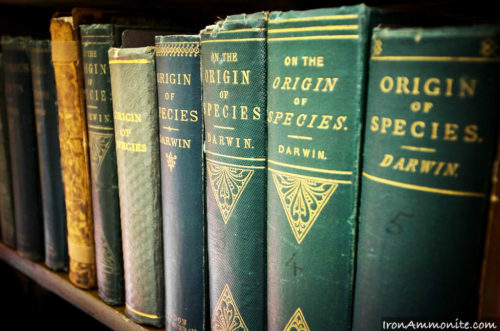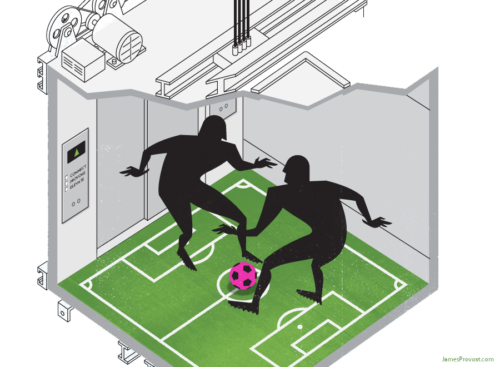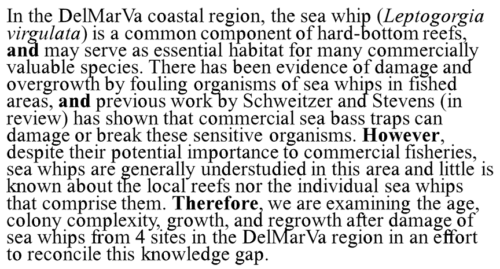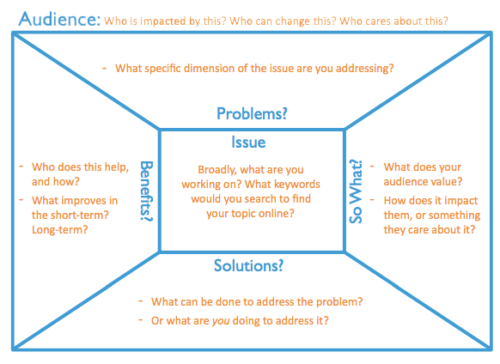Storytelling and Science: What's ABT got to do with it?
Rebecca Wenker ·If you had to group Abraham Lincoln, Charles Darwin, and the writers of South Park together based on a single characteristic, would you be able to do it? True, they are all men and were able to achieve great success in their respective fields, but that's not the answer I'm looking for. Therefore, I'm going to ask that you try again. The correct answer, which I not-so- subtly hinted at in bold, is that they all know the power of the ABT narrative structure.

The ABT, or 'and, but, therefore,' template is the key behind every good story. Introduced by Randy Olsen in his book and TEDMED talk, the ABT format provides context, creates conflict, and offers resolution in your narrative. The framework also extends beyond literal storytelling - anyone trying to communicate their ideas effectively to a wider audience can benefit from it! Whether you're Abraham Lincoln delivering the Gettysburg address to the American people, Charles Darwin publishing his breakthrough article on natural selection to skeptical scientists, or the writers of South Park creating engaging and funny storylines to entertain their viewers, the ABT structure can be utilized for communication.
Writing advice from Matt Stone and Trey Parker, the creators and writers of South Park. Posted by Fabian Valdez, License: Standard Youtube License
For those of us in the world of science, applying the concept of story-telling to the presentation of our various studies may not come naturally. We can often see this in tedious articles published in journals, or speakers at conferences who pile information on their audience without an explicit point. In an attempt to diverge from this tendency, our Science Visualization class applied the ABT structure to our own scientific work. For most of us, that meant transforming a thesis idea into an ABT elevator pitch. It sounds simple enough, but we soon learned it was trickier than we anticipated.

When creating an ABT statement, an important goal is to make it concise and compelling. However, many struggled with the dynamic between providing too much versus too little information. Others realized that word choice is also critical, as it shapes what your audience takes away from your statement and how they interpret what you are doing. For example, the phrase "healthy wetland" in one student's statement was deemed ambiguous in meaning and contentious by multiple classmates, while the use of acronyms was greatly disliked by our professor Dr. Bill Dennison as he believes they immediately narrow your potential audience. Our struggles highlighted the fact that an ABT statement is something you revise continuously, and sometimes it takes someone else's view to perfect it.
Looking at my own ABT statement below, I fell into the traps of:
- Too many 'ands'
- Using local language that may not be understood by a wider audience
- Replacing 'but' with 'however'
After critique from my peers, I was able to edit it so that there was concise information, language understood by a wide range of audiences, and a clear conflict statement. Hopefully it looks better to you too! If not, that's what continued peer review is for.


Another tool we used to help improve our communication efforts was the Message Box Workbook from Compass. This expanded upon the ABT statement by adding the elements of 'Benefits' and 'So What?' to our framework. These components make you think of what type of audience you are communicating with, and how to distill your message to coordinate with what they value and understand. We were presenting to a general scientific audience, or non-specialists in our field, for this exercise. Most of us were able to comfortably fill in the 'Issue,' 'Problems,' and 'Solutions' sections as they linked easily to our ABT statements, but the 'Benefits' and 'So What?' categories were harder. A big take away was to make sure your 'So What?' category isn't too generic, and to relate it specifically to the message you are trying to get across.
It all comes back to your audience! Who are they, what is their background, and why should they care about your work?

Overall, this exercise is useful for people all over the idea development spectrum. For those at the beginning of their research, the ABT framework helped them hone in on what they really want to ask and accomplish with their study. Those further along in their research learned how to pose a question in a way that is compelling to a wide range of audiences. Most importantly, both groups learned that you should always start a presentation with 'Why.' Why are you doing this, why should the audience care, and why is this important?
So, the next time you are preparing for a presentation (of any form), make sure to replace those 'ands' with 'buts,' embrace your inner social butterfly and ask peers for critique, and ask yourself: Who am I telling this story to, and why?
Next Post > A Long Love Affair with The Chesapeake Bay Part II
Comments
-
Erin 7 years ago
I really liked the introduction. It both drew you into the post and demonstrated the key concept of the blog. I think it is a well written summary of the discussion that we had. My one critique is that while I really liked that you included both of your ABT statements, the fact that they were formatted differently threw me off.
-
Jessie Todd 7 years ago
As previously stated, the opening comments really draw the reader in. It made me think, wow, I need to make sure my blog posts are interesting and to create something that keeps readers all the way until the end with catchy, relatable writing.
-
Lexy McCarty 7 years ago
Love the title! Really grabbed my attention and made me curious about what ABT stands for. I enjoyed how you started by using the ABT template in an example and then went on to explain what it means, how it is used, and how to write one. This kept me interested and made it seem less like you were talking at me, and more like we were having a casual conversation. I also really enjoyed how you included your ABT statement as evidence that some simple critique can go a long way (not that your original was awful by any means). The message box section was slightly dense to me. This was a hard concept that we all struggled with in class, so it's no surprise to me that this section slowed me down. Including an image of the message box definitely added some clarification. Overall, really enjoyed reading this!
-
Natalie Peyronnin 7 years ago
At first glance, I thought this blog was going to be too long to keep my attention, but it was very well written. I agree with an earlier commenter that the opening paragraph pulled in the reader and the author did not overly explain any concepts that can lead the reader to click elsewhere.
The song is a great addition!
-
Tom Butler 7 years ago
This is a well written blog! The opening paragraph was a good draw in, and the video offered evidence that the lessons from class are applicable to more then just in class scenarios. But I think that the soccer pitch reference was lost on me. Therefore I give the blog and A-! In all seriousness this was an easy to read blog with the text broken up well and made it enjoyable to read. The only thing I would think of changing would be maybe adding an image demonstrating how ABT feeds into the message box. You do a great job of explaining how to two are related and I think putting the two together in a single image might give it a little more punch. This was a very well written and laid out blog. Good job.
-
Bill Dennison 7 years ago
The title of Rebecca's excellent blog stimulated me to think of Tina Turner's song "What's Love Got To Do With It", and to modify her lyrics to the following:
“What’s ABT Got To Do With It”
7 Feb 2018
William C. DennisonYou must understand
Though the sight of your data
Makes my pulse react
That it's only the thrill
Of new knowledge
Good ideas attractIt's intellectual
Only logical
You must try to ignore
That it means more than thatOh, what's ABT got to do, got to do with it
What's ABT but a short hand narrative
What's ABT got to do, got to do with it
We need science
‘Cause science can be superlativeIt may seem to you
That I'm acting confused
When you're talkin’ to me
If I tend to look dazed
I've read it someplace
I've got cause to beThere's a name for it
There's a phrase that fits
But whatever the reason
Science does it for meI’ve been taking on a new direction
But I have to say
I’ve been thinking about ABT with affection
Therefore this approach makes senseOh, what's ABT got to do, got to do with it
What's ABT but a short hand narrative
What's ABT got to do, got to do with it
We need science
‘Cause science can be superlative

